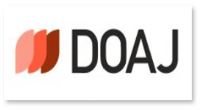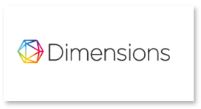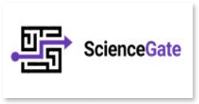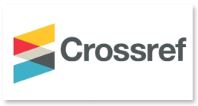PREDICTION MODEL FOR STUDENTS' ON-TIME GRADUATION USING ALGORITHM SUPPORT VECTOR MACHINE (SVM) BASED PARTICLE SWARM OPTIMIZATION (PSO)
DOI:
https://doi.org/10.30656/jsii.v12i1.9964Abstract
One of the indicators in assessing the tridharma of higher education outcomes and achievements is students' timely graduation and one indicator of the success of the higher education system is timely graduation. However, some students cannot complete their studies on time. In the process of completing the study, several problems emerged, one of which was in completing studies on time, there are problems that arise, such as students who are still repeating because there are grades that have not passed in the course, the Grade Point Average (GPA) is still lacking, the Semester Achievement Index (SAI) is still below the minimum, the total number of semester credit units (total credits) which still have not reached the minimum limit, then the number of active lecture statuses still exceeds 8 semesters, so this problem will have an impact on the accuracy of student study graduate data, where the target performance indicator for graduates is on time The student's target of graduating on time has not been achieved. The factors that cause the students not to graduate on time are not known. In identifying the problem, it was found that the Study Program does not have adequate information regarding the potential for students to graduate on time and the limitations of the study program in assisting students in completing on-time graduation The method used to solve this problem is by creating a prediction model for students' on-time graduation, so that students can receive adequate information regarding the potential for graduating on time. This research aims to create a prediction model for graduating on time using the Support Vector Machine (SVM) method based on Particle Swarm Optimization (PSO) with feature selection. information gain, so that the attributes selected and used are Semester Achievement Index 1, Semester Achievement Index 2, Semester Achievement Index 3, Semester Achievement Index 4, Grade Point Average (GPA) 1, Grade Point Average (GPA) 2, Grade Point Average (GPA) 3, Grade Point Average (GPA) 4, Semester Credit Units 1, and Semester Credit Units 4. The results in this study obtained accuracy values of 0.799, precision 0.851, recall 0.605 and AUC 0.86
References
[1] L. A. Mandiri, “Lampiran Peraturan BAN-PT No 10 Tahun 2021 tentang Instrumen Akreditasi Program Studi pada Program Sarjana Lingkup Kependidikan.” 2021.
[2] T. Kementerian Riset, “Standar Nasional Pendidikan Tinggi (SN Dikti),” Produk Hukum, vol. 49. pp. 21–23, 2015.
[3] F. Agama, I. Dan, P. Guru, and U. Djuanda, “Rencana strategis 2021-2026.” 2021.
[4] I. H. Witten, E. Frank, M. A. Hall, and C. J. Pal, Data Mining: Practical Machine Learning Tools and Techniques. 2016.
[5] L. Zahrotun, “Implementation of data mining technique for customer relationship management (CRM) on online shop tokodiapers.com with fuzzy c-means clustering,” in Proceedings of the 2017 2nd International Conference on Information Technology, Information Systems and Electrical Engineering (ICITISEE), 2018, pp. 299–303. doi: 10.1109/ICITISEE.2017.8285515.
[6] D. Sartika and D. I. Sensuse, “Perbandingan Algoritma Klasifikasi Naive Bayes, Nearest Neighbour, dan Decision Tree pada Studi Kasus Pengambilan Keputusan Pemilihan Pola Pakaian,” Jatisi, vol. 1, no. 2, pp. 151–161, 2017.
[7] R. P. S. Putri and I. Waspada, “Penerapan Algoritma C4.5 pada Aplikasi Prediksi Kelulusan Mahasiswa Prodi Informatika,” Khazanah Inform. J. Ilmu Komput. dan Inform., vol. 4, no. 1, pp. 1–7, 2018, doi: 10.23917/khif.v4i1.5975.
[8] S. Widaningsih, “Perbandingan Metode Data Mining Untuk Prediksi Nilai Dan Waktu Kelulusan Mahasiswa Prodi Teknik Informatika Dengan Algoritma C4.5, Naïve Bayes, Knn Dan Svm,” J. Tekno Insentif, vol. 13, no. 1, pp. 16–25, 2019, doi: 10.36787/jti.v13i1.78.
[9] I. D. Larasati, A. A. Supianto, and M. T. Furqon, “Prediksi Kelulusan Mahasiswa Berdasarkan Kinerja Akademik Menggunakan Metode Modified K-Nearest Neighbor (MK-NN),” J. Pengemb. Teknol. Inf. dan Ilmu Komput., vol. 3, no. 5, pp. 4558–4563, 2019.
[10] Suhardjono, W. Ganda, and H. Abdul, “Prediksi Kelulusan Menggunakan Svm Berbasis Pso,” Bianglala Inform., vol. 7, no. 2, pp. 97–101, 2019.
[11] P. C. N. et al., "Crisp-DM," SPSS Inc., vol. 78. pp. 1–78, 2000.
[12] Suyanto, Data Mining Untuk Klasifikasi dan Klasterisasi Data, Cetakan Pe. Informatika Bandung, 2019.
[13] N. Ye, Data Mining: Theories, Algorithms, and Examples. CRC Press, 2013.
[14] A. P. Engelbrecht, “Chapter 16 - Particle Swarm Optimization,” in Computational Intelligence: An Introduction, 2007, pp. 289–358.
[15] R. Chauhan and H. Kaur, Predictive Analytics and Data Mining: A Framework for Optimizing Decisions with R Tool. 2013. doi: 10.4018/978-1-4666-4940-8.ch004.
Downloads
Published
Issue
Section
License
Copyright (c) 2025 Syarif Hidayatulloh, Gandung Triyono , Kiki Ari Suwandi kosasih

This work is licensed under a Creative Commons Attribution-ShareAlike 4.0 International License.
- This work is licensed under a Creative Commons Attribution-ShareAlike 4.0 International License.
-
Author(s)' Warranties
The author warrants that the article is original, written by stated author(s), has not been published before, contains no unlawful statements, does not infringe the rights of others, is subject to copyright that is vested exclusively in the author and free of any third party rights, and that any necessary written permissions to quote from other sources have been obtained by the author(s).
- Information
- Notice about change in the copyright policy of the journal 'Jurnal Sistem Informasi (JSiI)' : "From Vol 1, onwards the copyright of the article published in the journal 'Jurnal Sistem Informasi' will be retained by the author"

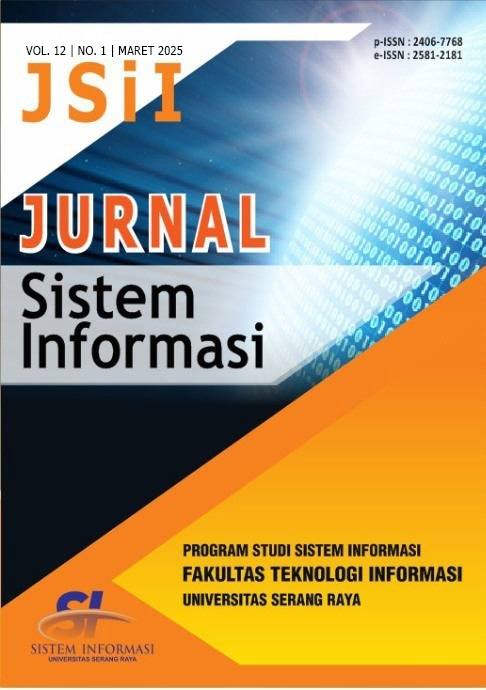





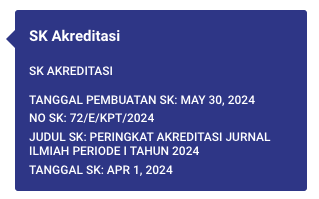





.jpg)



